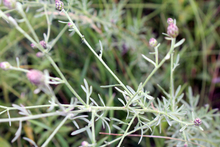Quick facts
Spotted knapweed is an invasive species.
- Spotted knapweed is found in artificial corridors such as gravel pits, railroad beds and field margins, and can spread to nearby woodlands and prairies.
- Seeds are dispersed by rodents, livestock and commercial hay.
- It can be difficult to identify.
- CAUTION: It can cause skin irritations for some people. Wear gloves, long sleeves, and pants when handling.
Spotted knapweed should be reported. The Minnesota Department of Natural Resources provides detailed recommendations for reporting invasive species.
How to identify spotted knapweed
- Spotted knapweed (Centaurea stoebe) is a short-lived (two to five years) perennial herbaceous plant, two to four feet high.
- Can persist as a rosette for one to four years.
Stem
- Basal leaves form a rosette that grows one to eight inches with wiry, hoary, branched stems during the final year.
- Often has many branches leading off the main stem.
Leaves
- Rosette leaves are bluish-green, covered in rough hairs, deeply lobed and can be up to six inches long.
- Leaves of the bolted plant are alternate, grayish, hoary; divided into lance-shaped lobes.
- Lower stem leaves resemble rosettes and decrease in size and frequency as they ascend the plant.
Flowers
- Small (0.3–0.6 inch diameter), oval, pink to purple flowers radiate from egg-shaped flower buds at the tips of terminal and axillary stems.
- Flower bud bracts have dark, upside-down “V” markings, giving them a spotted appearance.
- Blooms June to November.
Seeds
- Small, brownish, oblong seeds have small tufts of bristles that appear from June to February.
- One plant can produce 1,000 seeds that can survive in the soil for seven years.
Roots
- Stout perennial taproot.
- Lateral shoots form new rosettes near the parent plant.
Reviewed in 2022



